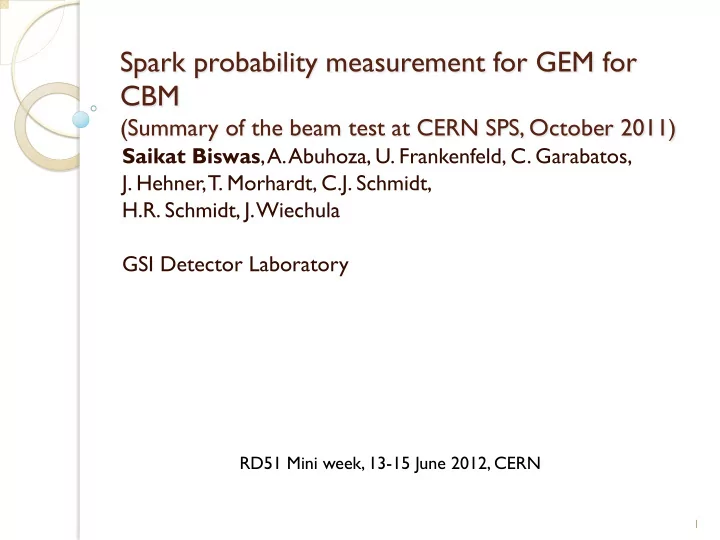

Spark probability measurement for GEM for CBM (Summary of the beam test at CERN SPS, October 2011) Saikat Biswas , A. Abuhoza, U. Frankenfeld, C. Garabatos, J. Hehner, T. Morhardt, C.J. Schmidt, H.R. Schmidt, J. Wiechula GSI Detector Laboratory RD51 Mini week, 13-15 June 2012, CERN 1
Outline of the talk Motivation Test set-up Analysis and Results Summary and future plan 2
GEM for CBM Triple GEM as a precise tracking detector in the Muon Chamber (MUCH) under the extreme conditions of the CBM experiment 3
Objective To measure the properties of GEM with shower and in particular Spark probabilities of Double mask and Single mask GEM 4
Summary of beam test Detectors Measured parameters ◦ 2 Double mask GEM ◦ 1 Single mask GEM ◦ Current ◦ Voltage Measurement with ◦ Trigger and GEM ◦ Pion beam Counts ◦ Pion beam with ◦ GEM signal absorber: Shower 5
Voltage distribution in GEM *! 5*789! !"#! 5;<=0!>,1! (!::! ! *! !"$! ! " ) ! ! *! !"%! 9;,?@=+;!>,1!)! (!::! !! *! !"&! ! " ( ! ! *! !"'! 9;,?@=+;!>,1!(! (!::! !! *! !"(! ! " ' ! ! *! !")! ! 7?-/A0<.?!>,1! (!::! ! ! *+,-!./0! ! 1,-!23456! 6
Details of the set up Gas mixture: Ar/CO 2 : 70/30 7 channel HVG210 power supply 2 sum-up boards are used for signal (2 × 128 6 × 6 mm 2 pads) for DM GEM 4 sum-up boards are used for signal (4 × 128 4 × 4 mm 2 pads) for SM GEM PXI LabView based DAQ is used 7
Set-up for Pion beam 8
Set-up for shower 9
Particle production during shower from FLUKA simulation Ref. A. Senger 10
Comparison of shower number from measurement and simulation 11
Current 12
Current and GEM counting rate: Pion beam 300 kHz 13
Current and GEM counting rate during Shower: Beam rate300 kHz 14
Current as a function of rate for DM GEM Pion beam Pion beam with absorber 15
Charge Vs. current for DM GEM Slope: -2.04 × 10 -12 Slope: -1.38 × 10 -12 Pion beam Pion beam with absorber 16
Current as a function of rate for SM GEM Pion beam Pion beam with absorber 17
Charge Vs. current for SM GEM Slope: -1.52 × 10 -12 Slope: -1.35 × 10 -12 Pion beam Pion beam with absorber 18
Efficiency 19
Efficiency during shower 20
Efficiency as a function of rate during shower 21
Efficiency for pion beam 22
Efficiency vs. rate for pion beam 23
Spark probability measurement 24
Methods of Spark detection Absence of signal ◦ Drop in the counting rate of GEM signals ◦ Data from sampling ADC Detection of high current ◦ Sudden increase in the Current (Slow) ◦ Built in Trip checker in HVG210 Power supply (Fast) 25
No spark during a spill Double Mask GEM with Fe Absorber 415_410_405 Gas: Ar/CO 2 : 70/30, Gas flow rate: 5 lt/hr, Particle rate: ~300 kHz, Pion beam 26
Drop in GEM counting rate Double Mask GEM 415_410_405 with Fe Absorber Gas: Ar/CO 2 : 70/30, Gas flow rate: 5 lt/hr, Particle rate: ~300 kHz, Pion beam 27
Sudden increase in current Double Mask GEM 415_410_405 with Fe Absorber Gas: Ar/CO 2 : 70/30, Gas flow rate: 5 lt/hr, Particle rate: ~300 kHz, Pion beam 28
Two sparks during a spill 412 - 407 - 402 Double Mask GEM with Fe Absorber Gas: Ar/CO 2 : 70/30, Gas flow rate: 5 lt/hr, Particle rate: ~300 415_410_405 kHz, Pion beam 29
Spark probability vs. global voltage for shower Discharge probability: No. of Discharge/ No. of incident particle 30
Spark probability vs. global voltage shower and pion beam 31
Spark probability vs. gain shower and pion beam 32
Spark probability vs. global voltage SM and DM 33
Off spill spark rate as a function of global voltage 34
Summary SPS test line has good conditions for our purpose 2 mm drift gap sub-optimal (3 mm standard!) Efficiency ◦ Rate dependency of efficiency observed Pion (signal close to threshold!) Shower (signal below threshold! Pick-up noise) Spark probability ◦ Spark measurement reliable also with noise (high thresholds) ◦ Comparable spark probability for pion beam and shower (high rate) ! ◦ Higher spark probabilities for lower intensities (shower) SM GEM ◦ Was in conditioning phase. ◦ No indication for different performance 35
Future plan: test beam Optimized drift gap (3 mm) Conditioned counters (SM and DM) Pixel readout ? 36
Acknowledgement Thanks to the RD51 collaboration for their support in the beam test…. Thank you for your kind attention ! 37
Back up slides 38
Conclusion The spark probability for pion beam is high. May be the gain is not measured correctly!! Effect of space charge !! Investigated in different conditions. to be understood the different spark probabilities. 39
Pulse height distribution 40
Method 100 sample is taken Difference of the maximum and minimum value of the channel is taken as pulse height 41
Fe 55 spectrum @ 400-395-390 V Resolution ~17.6% 42
For DM GEM at 400-395-390 with pion beam: Rate 300 kHz 43
For DM GEM at 415-410-405 during shower: Beam rate: 300 kHz 44
For SM GEM at 400-395-390 with pion beam: Rate 300 kHz 45
For SM GEM at 405-400-395 during shower: Beam rate: 300 kHz 46
Geometry of the experimental set-up 47
For SM GEM at 400-395-390 with pion beam: Rate 300 kHz 48
Definitions R beam Spill: > 0.5 <R* beam > C GEM C beam < 0.2 Spark: ¡ <R GEM > <R beam > Spill 49
Gain as a function of global voltage for SM GEM 50
Corrected voltage for GEM3 51
Discharge probability as a function of gain Discharge probability: No. of Discharge/ No. of incident particle Ref: S. Bachmann et al., NIM A 470 (2001) 548–561 52
Spark rate as a function of global voltage 53
Recommend
More recommend